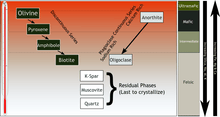Bowen's reaction series
| Discontinuous Series | Continuous Series | High | |||||||||||||||||||||
| Olivine | Plagioclase (Calcium rich) | ||||||||||||||||||||||
| Pyroxene | |||||||||||||||||||||||
| Amphibole | |||||||||||||||||||||||
| Biotite (Black Mica) | Plagioclase (Sodium rich) | Relative Crystallization Temperature | |||||||||||||||||||||
| Orthoclase | |||||||||||||||||||||||
| Muscovite (White Mica) | |||||||||||||||||||||||
| Quartz | |||||||||||||||||||||||
| Low | |||||||||||||||||||||||
Within the field of geology, Bowen's reaction series is the work of the petrologist, Norman L. Bowen[1] who was able to explain why certain types of minerals tend to be found together while others are almost never associated with one another. He experimented in the early 1900s with powdered rock material that was heated until it melted and then allowed to cool to a target temperature whereupon he observed the types of minerals that formed in the rocks produced. He repeated this process with progressively cooler temperatures and the results he obtained led him to formulate his reaction series which is still accepted today as the idealized progression of minerals produced by cooling magma. Based upon Bowen's work, one can infer from the minerals present in a rock the relative conditions under which the material had formed.[2]
Description

The series is broken into two branches, the continuous and the discontinuous. The branch on the right is the continuous. The minerals at the top of the illustration (given aside) are first to crystallize and so the temperature gradient can be read to be from high to low with the high temperature minerals being on the top and the low temperature ones on the bottom. Since the surface of the Earth is a low temperature environment compared to the zones of rock formation, the chart also easily shows the stability of minerals with the ones at bottom being most stable and the ones at top being quickest to weather, known as the Goldich dissolution series. This is because minerals are most stable in the conditions closest to those under which they had formed. Put simply, the high temperature minerals, the first ones to crystallize in a mass of magma, are most unstable at the Earth's surface and quickest to weather because the surface is most different from the conditions under which they were created. On the other hand, the low temperature minerals are much more stable because the conditions at the surface are much more similar to the conditions under which they formed.
References
- ↑ Tilley, C. E. (1957). "Norman Levi Bowen 1887-1956". Biographical Memoirs of Fellows of the Royal Society 3: 6–26. doi:10.1098/rsbm.1957.0002. JSTOR 769349.
- ↑ Klein, Cornelis and Cornelius S. Hurlbut, Jr., Manual of Mineralogy, Wiley, 20th ed. 1985, p. 476 ISBN 0-471-80580-7